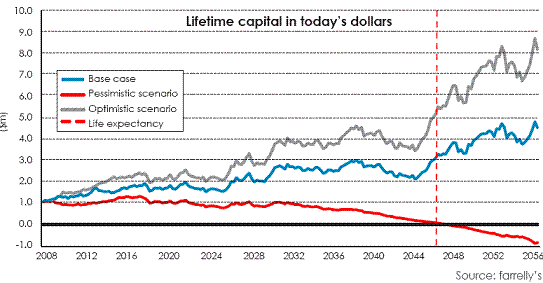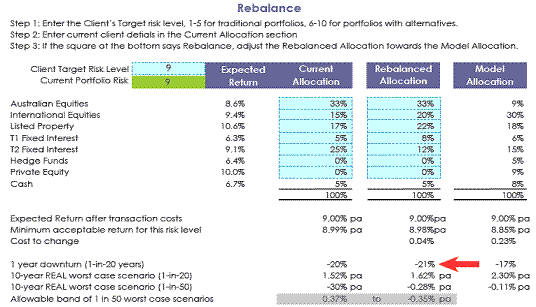Risk profiling is generally agreed to be an important part of the financial planning process – and, yet, it is something that generates large measures of skepticism, controversy and, from time to time, attention from the regulators. The issues seem to arise either because risk profiling practices are ill founded, or because the means used to measure risk tolerance are too opaque, or because, sometimes, profiling is not done at all.
Leading the ill-founded practices are those tools based on faulty premises. Chief amongst these is the confusion between risk tolerance and risk capacity. For most investors, financial risk capacity can be described as whether an investment strategy will meet their cash flow requirements. It’s a financial concept. On the other hand, risk tolerance is the investor’s ability to emotionally cope with the ups and downs of the market. It’s a psychological concept. The two are fundamentally different. A wealthy person with modest spending habits may have huge financial risk capacity, but little tolerance for volatility. An impoverished stockbroker may have huge risk tolerance, but little capacity to absorb adverse outcomes. Too many risk profiling questionnaires mix questions that come up with some sort of average of the two, whereas the aim should be to identify which of the two is critical for any particular investor.
Another ill-founded practice runs along these lines. “We assess you as having high risk tolerance therefore we recommend investing in an aggressive portfolio”, regardless of whether the investor actually requires an aggressive portfolio to meet his or her needs. Or, to put it another way, we aim to find how much pain an investor can tolerate, and then give them a portfolio that ensures that they will experience that pain at some time. Instead, we should be aiming to create portfolios that will meet their needs with the minimum amount of pain along the way.
The opaque nature of many profiling tools is also an issue. It is hard to assess why particular clients have registered the score they have, so the results have to be accepted as a matter of faith. Further, if it is not clear where the results have come from, it is hard to assess whether the test has validity.
Finally, and most seriously, some planners choose to make little serious attempt to formally risk profile their clients, and this really gets the attention of the regulators!
Assessing financial risk capacity
Traditionally, financial risk capacity has been assessed using a one-dimensional process of forecasting cash flow needs, then projecting whether these cash flow requirements will be met by a single forecast rate of return. Clearly, this has a number of shortcomings. Firstly, there is the oft-quoted observation that a downturn in the early years of retirement can result in funds running out early, even if the average return is as expected. Secondly, and of much more significant risk, is that long-term returns turn out to be lower than expected. If 8% per annum is your best estimate of future returns, and based on that, the plan shows the client’s funds lasting just until their life expectancy, there is a 50% chance the plan will fail (i.e. there is a 50/50 chance that returns will be higher or lower than your estimate.) Finally, there is longevity risk, the chance the retiree lives too long.
Assessing financial risk capacity with the ISI Projector Page
The farrelly’s Investment Strategy Implementor’s Projector page is designed to help assess risk capacity. The output is shown in Figure 1. This tool enables subscribers to assess whether any particular plan is likely to provide the investor with the required level of cash flow over their lifetime. Critically, it not only shows the expected outcome, (the blue line) but also a 1-in-20 worst case outcome (the red line). By I-in-20 worst case outcome, what we mean is that we can be 95% sure that the actual outcome will be better than the outcome shown by the red line. This of course implies a 5% chance (or I-in-20 chance) that the outcome will be worse than the red line – but this is a far more acceptable level of risk than the 50% chance of failure implied by the old method.
Figure 1: farrelly’s Investment Strategy Implementor - Projector output

Inputs required by the Projector feature include current assets, earning and spending estimates, plus estimates of life expectancy and tax.
Life expectancy is one of the inputs required. This is normally longer than the life tables suggest. To get a more useful assessment of a client’s life expectancy, farrelly’s can recommend a new website – mylongevity.com.au – brainchild of Australian financial planning stalwart, David Williams. The client completes an online questionnaire detailing lifestyle, and family history. The output includes both a core estimate and a life expectancy range. I completed it in about five minutes and learned that my life expectancy was 90 years rather than the 82 years predicted by life tables. A tribute to clean living!
Average tax on investment earnings , pre- and post-retirement, is another required input. While this does not take into account the nuances of variable tax rates and tax planning, it will get quite close to the mark, particularly given we are estimating very long periods of time and tax rates do change over time.
Expected returns for any given portfolio are taken directly from the Rebalance page, so do not have to be re-estimated.
Assessing psychological risk tolerance
farrelly’s endorses two approaches to assessing psychological risk tolerance. Firstly there is the risk tolerance questionnaire available on the farrelly’s forum on the PortfolioConstruction Forum (www.portfolioconstruction.com.au/farrelly’s). It consists of just three questions and is designed to help you and you client come to an agreement on how big a short-term downturn they can tolerate. It does not purport to measure the client’s actual risk tolerance, just for you to agree where it sits.
Secondly, farrelly’s endorses the FinaMetrica service. It objectively assesses risk tolerance and allows your clients to explicitly instruct you as to how they wish to resolve any trade-off between their risk tolerance and the risk required in their financial plan.
We have integrated both approaches into the farrelly’s Investment Strategy Implementor. The embedded FinaMetrica page allows users of the FinaMetrica service to translate a FinaMetrica risk score into a likely tolerance to short-term downturns. This can in turn be compared to the likely short-term downturn of any particular portfolio generated by the Rebalance page of the Implementor. In the example below, the recommended portfolio has a 1-in-20 chance of a 21% decline in any one year.

Get it right
The key points here are:
-
firstly, ensure that any particular portfolio is within the bounds of both a client’s risk tolerance and risk capacity. Just getting one right is not good enough;
-
secondly, the farrelly’s Investment Strategy Service has the tools you need to complete this task in a logical, practical and transparent manner; and,
-
finally, make sure you do, in fact, go through the exercise. The regulator is hot on this one, even if you are not!
Tim Farrelly is principal of farrelly's, the Australasian financial services industry's first dedicated asset allocation research house. More info >
©
2008 Portfolio
Construction Forum, Brillient Investment Pty Ltd ABN 19 122 531 337.
All rights reserved. Refer
Terms &
Conditions of Use
.
